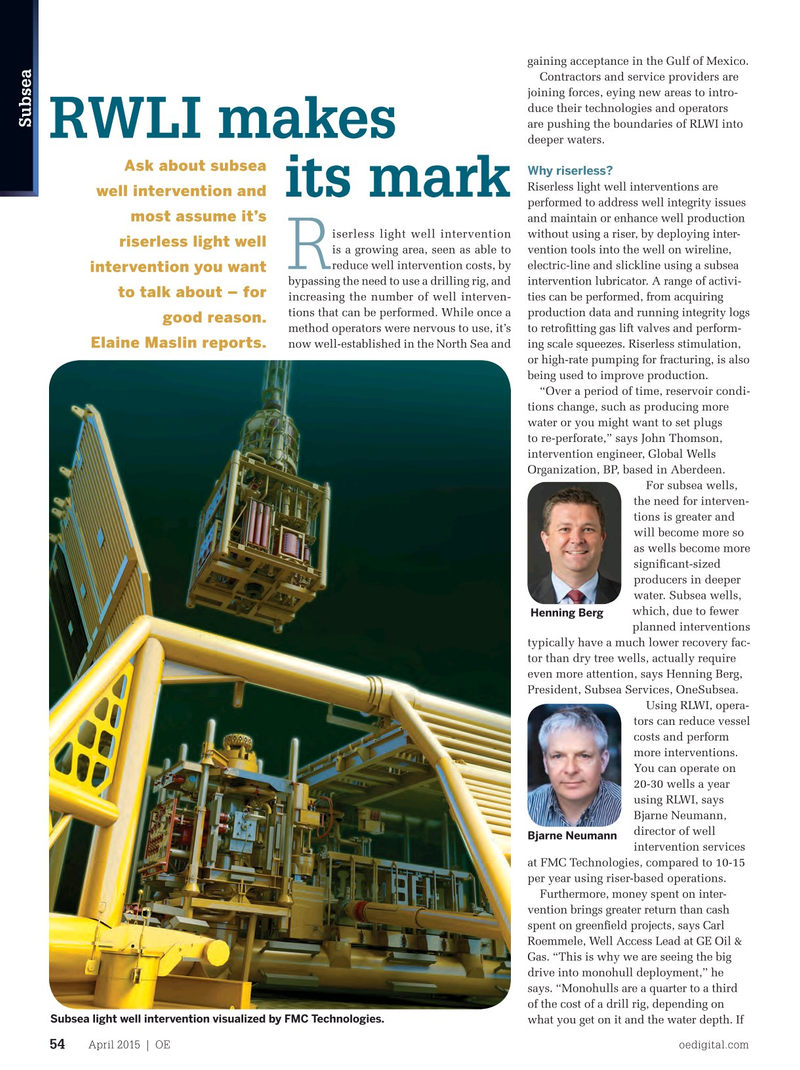
Page 52: of Offshore Engineer Magazine (Apr/May 2015)
Read this page in Pdf, Flash or Html5 edition of Apr/May 2015 Offshore Engineer Magazine
gaining acceptance in the Gulf of Mexico. you can go behind a rig to tidy up wells,
Contractors and service providers are do testing or pick up intervention, you joining forces, eying new areas to intro- can save rig days and money. Most reports duce their technologies and operators you read predict double-digit compound
Subsea are pushing the boundaries of RLWI into annual growth rate in the intervention
RWLI makes deeper waters. space over the next 3-5 years.”
Ask about subsea
Why riserless? Dominating the market
Riserless light well interventions are To date, Norway and the UK North well intervention and its mark performed to address well integrity issues Sea have been a front runner in RLWI, most assume it’s and maintain or enhance well production due to the fact it has the most mature without using a riser, by deploying inter- iserless light well intervention subsea trees in the world, Neumann riserless light well vention tools into the well on wireline, is a growing area, seen as able to says, with dedicated riserless light well
R electric-line and slickline using a subsea reduce well intervention costs, by intervention vessels established in both intervention you want intervention lubricator. A range of activi- bypassing the need to use a drilling rig, and basins. “Operators are now so familiar to talk about – for ties can be performed, from acquiring increasing the number of well interven- with RLWI they even have a vision all production data and running integrity logs tions that can be performed. While once a intervention will be done riserless in good reason. to retroftting gas lift valves and perform- method operators were nervous to use, it’s the future. That is their target because it ing scale squeezes. Riserless stimulation, now well-established in the North Sea and is more cost effective. It is a technology
Elaine Maslin reports.
or high-rate pumping for fracturing, is also proven over the years to be reliable, safer being used to improve production. and more effcient,” he says.
“Over a period of time, reservoir condi- BP has had a dedicated well inter- tions change, such as producing more vention campaign west of Shetland on water or you might want to set plugs the UK Continental Shelf, under a long to re-perforate,” says John Thomson, term alliance led by Island Offshore intervention engineer, Global Wells (with Oceaneering, FMC Technologies
Organization, BP, based in Aberdeen. and Altus Intervention) using the Island
For subsea wells, Constructor, since 2009, as well as the need for interven- operations on its other North Sea assets tions is greater and with Helix Energy Solutions, using the will become more so Seawell, Well Enhancer and Skandi as wells become more Constructor. The frm has 197 subsea signifcant-sized wells on the UKCS, the deepest in about producers in deeper 500m water depth, west of Shetland, water. Subsea wells, where the weather window spans just which, due to fewer April to mid-September.
Henning Berg planned interventions John Thomson, intervention engineer, typically have a much lower recovery fac- Global Wells Organization, BP, based in tor than dry tree wells, actually require Aberdeen, says the long-term contracts even more attention, says Henning Berg, have meant continuous improvements
President, Subsea Services, OneSubsea. have been made, both around manag-
Using RLWI, opera- ing the challenging weather conditions tors can reduce vessel west of Shetland [OE: January 2015] and costs and perform operationally. In 2007, BP performed one more interventions. subsea well intervention operation in
You can operate on the North Sea a year. It is now about 12, 20-30 wells a year in that short season, says Thomson, and using RLWI, says they’re delivered on time and on budget.
Bjarne Neumann, “The North Sea is not a challenge any director of well more [for RWLI], it is becoming routine”
Bjarne Neumann intervention services he says. at FMC Technologies, compared to 10-15 Colin Buchan, Wells Engineering per year using riser-based operations. Manager Subsea Well Intervention at
Furthermore, money spent on inter- Shell, says Shell frst used RWLI in the vention brings greater return than cash North Sea in 1994. Since then the tech- spent on greenfeld projects, says Carl nology has been used more and more in
Roemmele, Well Access Lead at GE Oil & the North Sea and now in the deepwater
Gas. “This is why we are seeing the big basins in the US Gulf of Mexico, Brazil drive into monohull deployment,” he and West Africa. However, to be fully says. “Monohulls are a quarter to a third adopted in deepwater, technology, vessel of the cost of a drill rig, depending on capabilities and economic viability need
Subsea light well intervention visualized by FMC Technologies. what you get on it and the water depth. If to be addressed.
April 2015 | OE oedigital.com 54 054_OE0415_Subsea_RWLI.indd 54 3/23/15 2:33 PM

 51
51

 53
53